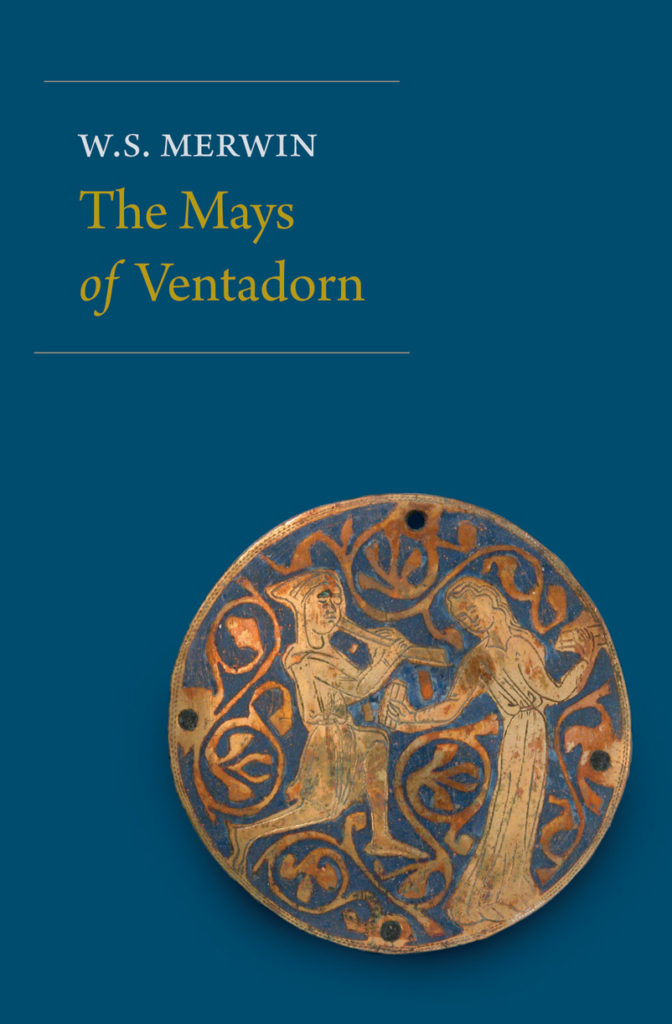The Mays of Ventadorn
The Mays of Ventadorn, by W.S. Merwin.
Copper Canyon Press, 2019,
133 pages, paper, $16.00
ISBN: 978-1-55659-546-2
Ieu sui Arnaut, que plor e vau cantan. (I am Arnaut, who weeps and goes singing.)
—Dante Alighieri, Purgatorio, XXVI
The Mays of Ventadornby W.S. Merwin is part historical mending project and part memoir, tracing a lifetime’s passion for the landscape and brief period and work of the troubadours of the high Middle Ages, along with their antecedents and subsequent influence. The book wanders, picking up partial storylines and forgotten threads. By these methods, it also resists a historical mono-narrative, asserting both Merwin’s personal idiosyncratic journey and the extent of the historical unknown. Content with piecing together evocations from the fragments, and with a light touch, the book reveals a rich poetic history of courtly love, the nature of specific linguistic and poetic influence, and the mobility of poetic forms that travel across multiple geographies and times.
One summer in his early twenties, Merwin explored the remote region of the Quercy, in southern France. At that time—it would have been the early 1950s—the region seemed to him to have barely changed between the last of the Crusades and World War I, dotted as it was by small villages described by traditional peasant farming methods: cows yoked to hay carts ambling in lanes, chickens scratching in bare soil in the silence of noon-day yards. He was drawn to an old abandoned house, overgrown by brush at the edge of a small village; by a series of chance meetings came to buy the place, and proceeded to live within the rhythms of the small Occitan village for some years.
Drawn organically to this rural countryside, Merwin also understood he was in the region that had seen the great flowering of troubadour poetry in the late 11thcentury, but the history and poems of this wandering class of musicians remained to him only as “odd tatters of a disintegrated tapestry, single pieces surviving from a once brilliantly colored puzzle, elegant but isolated and adrift in poor light.” He had read a few rough translations of poems by Bertran de Born and Jaufre Rudel, including rather ornate translations by Ezra Pound, yet he did not speak Occitan. As a young man, Merwin had met Pound, who advised him to “read seeds not twigs,” and this advice, along with his own predispositions, led Merwin slowly along a path of discovery and affection for the work of Bernart de Ventadorn, who grew up in Moustier-Ventadour, not far from the Quercy and the ruins of the Chateau of Ventadorn.
The hawthorn or may tree, a shrub or small tree of the family Rosaceae, grows wild around the Chateau and in the entire south of France. It blooms in May, its almondy scent heralding the relief of spring, the season famous for love. In the Occitan region, the advent of spring has been celebrated with festivals of fertility since long before Christianity. Much of troubadour poetry concerns itself with this season of desire, but too of longing and distance, the unique pains of forbidden love, and the uglier repercussions of deception, jealousy, and heartbreak. Indeed, “The recurring burden of Bernart’s song is distance,” notes Merwin, “the distance between the lover and the beloved.” And like much of the world’s love poetry, this distance is physical and geographic as well as social and temporal.
Connected to his own desire to hear the “living flow of the whole poetry” of the troubadours, Merwin describes “the craving to hear it [as] what brings us back to all poetry, of our own time or any other, hoping that something has been carried across a great distance like water in the hands: the life of the original.” Often we can hear Bernart most distinctly, he recounts, in fragments such as this one:
Alas, I knew so much, I thought,
about love, and I knew so little!
For there is no way for me not
to love her who yields none at all.
She took herself and took my heart,
my self and all the world with her,
went and left only desire
and the longing of my heart.
Any lover of Rumi’s poetry will recognize the powerful desire for an inaccessible beloved. While Merwin was still in school, the Arabic roots of troubadour poetry were being revealed though the work of A.R. Nykl’s Hispano–Arabic Poetry. The introduction of rhyme and the thematic strains of individual forbidden love can be traced to the medieval Muslim territory of al-Andalus that covered most of the 2Iberian Peninsula at the time. A beacon of learning and cultural influence, the Arab-Spanish courts contributed to a great expansion of art and literature borne by a traveling class of court poets, much like the later troubadours. Followed further, we can trace this thread to Dante Alighieri’s Divine Comedy and the development of the sonnet.
At times The Mays of Ventadornseems to draw on Merwin’s own deep longing for another time and place. Why indulge in such exercises of nostalgia in the 21stcentury, whose horrors feel so very urgent and are different from that of the 20th, let alone those of eight hundred years ago, between the First and Albigensian Crusades, when the troubadours wrote? What value can the poets of courtly love and chivalry offer us today? The same questions plagued Carl Appel, another traveler of the past, who published his pioneering work on Bernart de Ventadorn in 1915. Speculating on Appel’s work, Merwin notes, “How ridiculous the tinkling of the medieval poet’s lyre sounded in the midst of the roar of modern weapons, and how ridiculous the quest…for some minute fragment of truth at a time when a storm of lies was sweeping the planet.” Certainly that fragment, the delicacy of what really matters to us, is worth saving and noting with care. And it is clearly these fragments that Merwin gathers and stitches together in The Mays of Ventadorn.
W.S. Merwin died at the beginning of this year. He leaves for us over 60 volumes of poetry, translation and prose, records of his research, and study and poetic contribution. The Mays of Ventadorn, re-issued this year by Copper Canyon Press in their efforts to keep Merwin’s vast knowledge in circulation, reveals the fluidity of his process and his fidelity to his artistic forbears. If making poems entails a stitching together of the world, Merwin has carried forward the poetic fragments that travel to us from the troubadours and made legible these histories, ensuring their survival. Through research, translation, and longing, the book stitches together not just the vidasand work of the troubadors and their influences, but the cloth of a poetic life. Merwin’s work is tied up in these histories. The Mays of Ventadorn establishes not just a history of exchange and influence, but a poet’s place in making that tapestry.
— Julie Poitras Santos


